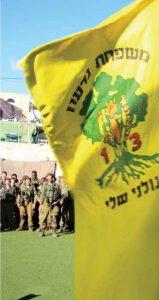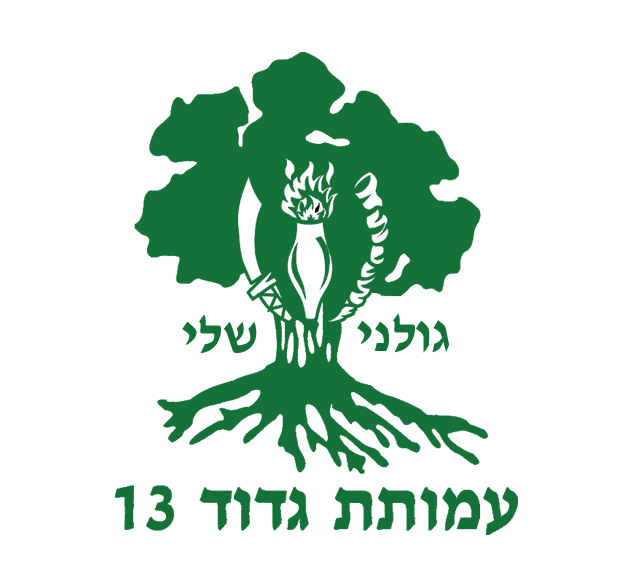Gdud Gideon, a 3000-year-old heritage.
 In Gideon’s war against the Midianites in the Jezreel Valley, he gathered 32 thousand warriors, from the sons of Manasseh, Asher, Zebulun and Naphtali to fight in Midian. Gideon is instructed to release everyone who is afraid and anxious. As a result, Gideon was left with ten thousand warriors. The Lord asks to carry out another sifting and ordered Gideon to carry out a water-drinking test. The warriors were led to the spring, where Gideon watched them while they quenched their thirst, those who knelt down and licked the water with their tongues, “as a dog licks” (ibid., 7:17) were punished, those who drank with their hands, three hundred in number, were chosen to fight.
In Gideon’s war against the Midianites in the Jezreel Valley, he gathered 32 thousand warriors, from the sons of Manasseh, Asher, Zebulun and Naphtali to fight in Midian. Gideon is instructed to release everyone who is afraid and anxious. As a result, Gideon was left with ten thousand warriors. The Lord asks to carry out another sifting and ordered Gideon to carry out a water-drinking test. The warriors were led to the spring, where Gideon watched them while they quenched their thirst, those who knelt down and licked the water with their tongues, “as a dog licks” (ibid., 7:17) were punished, those who drank with their hands, three hundred in number, were chosen to fight.
At night, at the beginning of the middle camp, Gideon says to his men: “From me you will see and so you will do” (ibid., 7:17).
Gideon divided his warriors into three groups and gave each man an urn with a burning torch and a trumpet inside. After they surrounded the Midian camp, they broke the jugs and blew the shofars. The move caused great panic in the Midian camp which began to flee for its own sake, in the meantime the people of Naphtali, Asher and Manasseh joined Gideon. Gideon sent angels to ask the people of the tribe of Ephraim to reach the crossings of the Jordan and block their retreat towards the Jordan. They do so, and even succeed in killing the two ministers Raven and Zeev and bring their heads to Gideon as proof, but Gideon is not satisfied with removing the danger and goes in pursuit of the kings of Midian who fled, in order to strike them with an eternal blow. Zebah and Zalmunna, two kings of Midian, Gideon continued with the elite force that numbered only 300 men and arrived by a detour to Karker where the kings of Midian with 15,000 men camped safely. After he attacked the camp by surprise and succeeded in horrifying it, he pursued the two kings and succeeded in capturing them. The people of Israel asked Gideon to rule over them, but Gideon refused. In return, he created a vest – a memorial tombstone from the gold jewelry that fell as loot from the Midianites. Gideon married many wives and they bore him seventy sons and the land was quiet for forty years.
The legacy of the 13th Gideon Battalion
The 13th Battalion was established on February 22, 1948 and was the third battalion in the Golani Brigade – Brigade No. 1 – hence its number. The battalion was named after the biblical judge Gideon ben Yoash, because at its beginning, the battalion occupied the Bekat Beit Shan sector that was Gideon’s property. The regiment’s symbol is the tree of Golani with a sword and a pitcher and a trumpet on it – in the Bible, Gideon divided his warriors into three groups and gave each man a pitcher with a burning torch and a trumpet inside. The Gdud took part in all of Israel’s wars.
- In 1948, as part of the War of Independence, the soldiers of the battalion took an extensive part in the various activities. In the occupation of the Shan Valley, Zarein and the isolation of the wing in the Jezreel Valley. Conquest as Occup el Hawa (star of the Jordan). Taking over the city of Nazareth. The battalion also took part in “Operation Assaf” – the occupation of Sheikh Noran (within Kibbutz Magen) and Hirbat Ma’in (between Nirim and Nir Oz) and “Operation Horeb” in which they carried out a deception battle in the area of Tel Abbasan near Kissufim in order to capture Mashlot 86.
- In 1956, as part of the Sinai War, the soldiers of the battalion took part in the battle to occupy the Rafah Junction outposts. The purpose of the occupation was to free the junction so that armored forces could move towards Al-Arish and from there to Sinai. On the first of November, the brigade’s tasks were completed – the Rafah compound was occupied and the armored brigade began to move towards El-Arish.
- In March 1962, Hagadodad fighters participated in the occupation of the Nukaiv outpost in light of the Syrian harassment of the Israeli fishermen in the Kinneret.
- In May 1965, as part of Operation “Tzokk Sela”, the soldiers of the battalion blew up the building of the Adnan Tzedki farm near Khirbat Shona in Jordan.
- In October 1965, as part of Operation Mazanim, the fighters raided the Lebanese village of Hula, as part of military pressure on the Lebanese authorities in order for them to stop the activities of the terrorists in their area.
- In June 1967, as part of the Six Day War, the battalion’s mission was to form a brigade reserve and act, if necessary, in the occupation of Tel Azziat, Banias and Tel Hamra. In practice, two companies under the command of the Majd cleared the Zaora compound and the village of Jab al-Mis, a force under the command of the Samgad captured the Banias compound, then the forces of the Majd and the Samgad joined forces and advanced to Quneitra. Later, a platoon under the command of the Major General was sent to Hermon, took control of the posts on the peaks of Hermon and raised the Israeli flag.
- In 1973, as part of the Yom Kippur War, the battalion was a reserve in the Northern Command. The battalion captured the plateau outposts up to Hermon. At the head of the 13th Battalion’s pride in the war is a simple fact – not a single outpost in the battalion’s sector, with the exception of the Hermon outpost, fell to the Syrians in the war, and when the Northern Command issued a withdrawal order on Sunday morning, the Major General said that for him and the battalion there was only one possible answer – refusal command.
As a result, the sentence was coined in the history of the State of Israel: “You will not cross, here are fighting warriors”! - The Agrant Committee held an inquiry into the refusal of the General Assembly to withdraw from the outposts. After an in-depth examination of the matter by the chairman of the committee (the president of the Supreme Court) and the State Comptroller, it was decided that the General Assembly acted correctly when it insisted that there was no need to withdraw from the outposts and received many praises.
- In the Lebanon sector, the battalion carried out a myriad of activities, the most prominent of which include the occupation of the town of Al-Khyam in Operation “Litani” in 1978, the occupation of the village of Sil by a combined force of fighters from the battalion and tanks from the 74th Battalion, in the most difficult battle of the First Lebanon War, which enabled the The crossing of the 98th and 91st divisions on the coastal axis at the “bottleneck” point on the way north to Beirut, as well as fighting in the village of Markaba in the Second Lebanon War.
- In recent years, most of the battalion’s activities have been concentrated in the Gaza Strip, ongoing activities for the security of the residents of the area and many operations to maintain peace and security.
Today the battalion consists of 5 companies: the operational combatant companies, A, B and C, the auxiliary company and the headquarters company.
The battalion today continues to be a professional battalion with a strong spirit, and continues with dedication and excellence in the ongoing security work in all sectors.
“A sword for God and for Gideon”


